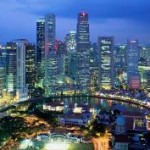 As our urban spaces grow more crowded, planners in Hong Kong and Singapore delve deeper into what makes each metropolis tick.
As our urban spaces grow more crowded, planners in Hong Kong and Singapore delve deeper into what makes each metropolis tick.
Urban living is a trend that’s not going away.
Half the world’s population lives in cities and that figure will hit almost 70 per cent by 2050. What’s more, cities are becoming denser, especially in Asia.
It might sound a gloomy outlook, particularly when cities that regularly rank high as the “world’s most liveable” – Melbourne, Vancouver, Vienna – are all low-density ones. But high-density cities and liveability need not be at odds.
After conducting a study in 2011 on sustainable development in Hong Kong, the Urban Land Institute, a non-profit research group, teamed-up with the Centre for Liveable Cities in Singapore to study high-density living in the Lion City.
The result of their year-long research was released at the end of January, and Scott Dunn, vice-president at Aecom Technology Corporation in South Asia, and John Fitzgerald, ULI senior vice- president (Asia Pacific), were in Hong Kong to spread the word last week.
While there is so much that Singapore has done right – in many ways it’s a great case study on how to build a harmonious high-density city – it still has its shortcomings.
Fitzgerald says cities can learn from each other.
“As we were going through the process in Singapore, our members in Singapore said: ‘But what about in Hong Kong? While we have a great planned city and it’s very efficient, we admire that organic vibrancy you have on the street in Hong Kong that we don’t see much of at home.”
Singapore’s founding father Lee Kuan Yew is credited for laying the foundations of a thoroughly modern, efficient and well-planned city. That early big-picture planning helped create a mindset that viewed city planning decisions holistically.
Dunn says that while there is some push and pull between departments, “Singapore does come together a lot better than many other cities in terms of working on projects through the different agencies”.
So what can Hong Kong glean from Singapore’s experience? Make utilitarian spaces work harder, says Dunn, so they can perform dual or even multiple functions.
Singapore’s Marina Barrage is a utility building that pumps water from the marina into the reservoir, but the roof of the building is public open space that serves as a park. It also has a museum and an education facility.
Likewise, the rail corridors, particularly elevated ones, have a dual function of providing cover for cycling and pedestrian paths beneath.
Dunn is a former Hong Kong resident and his suggestion for the city, while not new, bears repeating.
“A lot of the waterfront area in Hong Kong is owned by a utility department. It’s often fenced or gated and it becomes dead space,” he says. “You want to strive for the goal of 100 per cent publically accessible waterfront.”
Moving large utilities underground is another way of freeing-up land for development, something Hong Kong has been doing a good job of, says Dunn, but more can be done.
Drawing nature closer to the city softens the edges of a city and helps improve air quality. Singapore has taken this on board very seriously and almost half of the city is now under green cover.
“Green roofing is a huge opportunity in Hong Kong because there is a lot of roof space,” says Dunn.
ULI is not a lobby group. Rather, it draws people together from different fields to get a conversation going. In Hong Kong, Dunn and Fitzgerald’s presentation drew an audience from government departments as well as the private sector.
And the next step? The report: “10 Principles for Liveable High-Density Cities: Lessons from Singapore” is being translated into Chinese.
“It will be presented and distributed to planning officials on the mainland. There’s a lot of interest to hear what are the lessons from Singapore,” says Fitzgerald.
How Singapore Does It
Top tips for urban living in the Lion City:
- Think ahead – a combination of long-term plans, plans with responsive land policies, and good design means the city doesn’t feel overly crowded.
- Embrace diversity – this has worked by creating a sense of inclusiveness through encouraging greater interaction.
- Draw nature to the people – in addition to parks scattered across neighbourhoods, water bodies also break up the urban landscape.
- Affordable mixed-use neighbourhoods – when shops, schools, and recreation areas are within easy reach there is less need to commute to the city centre.
- Make public spaces work harder – unlock otherwise dead space and put it to work as spaces for commercial and leisure activities.
- Relieve density with variety – Singapore mixes high-rise with low-rise buildings, reducing the sense of being in a crowded space.
- Activate spaces for greater safety – smart urban design makes for a stronger sense of personal security.
- Promote innovative solutions – a need for non-traditional solutions has led to resource-efficient technologies.
- Forge 3P (people, public, private) partnerships – government and stakeholders work together for a collective responsibility towards a neighborhood.
Kate Whitehead
property.post@scmp.com
Speak Your Mind
You must be logged in to post a comment.